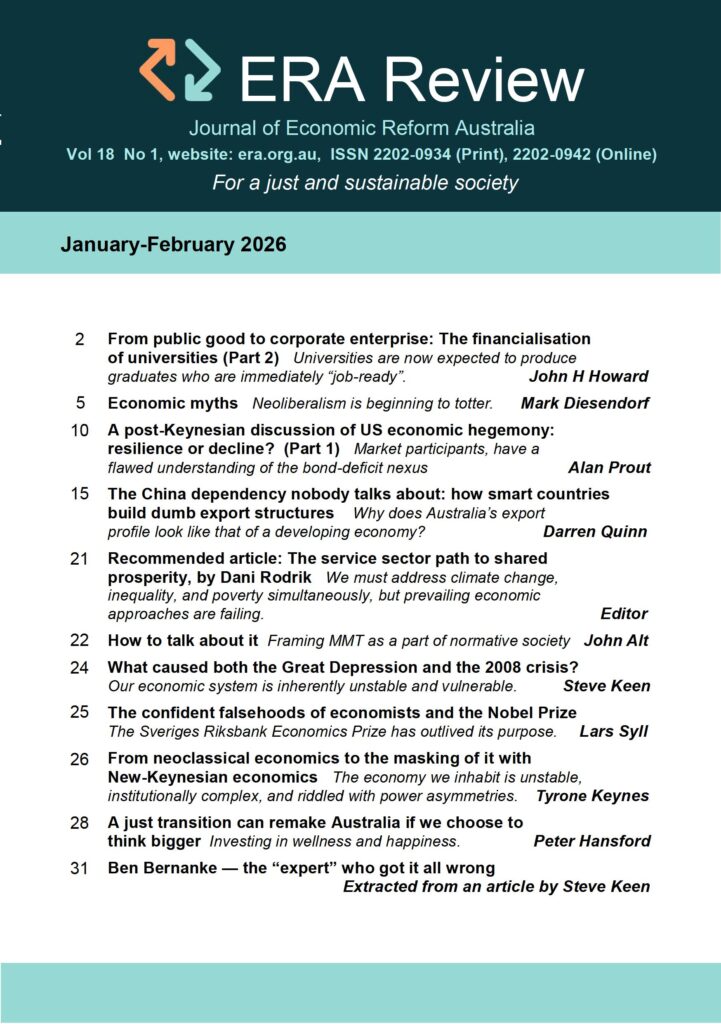Government debt vs household debt: ‘good’ and ‘bad’ debt explained
Steven Hail

To add more private debt – and to add it to the young – is the height of folly … We are in the grip of a mass delusion and we have been now for 30 years or more.
It is difficult to identify the most ludicrous policy proposal to emerge from our politicians in recent times.
But an increase in our already high university fees, when in a smart country there should be no university tuition fees at all, or at most a token charge, is definitely on the short-list.
We have as much private debt as we do in Australia, largely because we do not have enough government liabilities – call them “government debt” if you must. And if we are to use the term “government debt” for something which is better thought of as a form of money
– and is not debt in the conventional sense of the term at all in a country with a monetary system like ours – can we please dispense with all this nonsense about “good debt” and “bad debt”?
There is good government spending and less good government spending – for sure. Government spending involves the use of real resources in our economy and should always be carried out for the public purpose. It can add to inflationary pressures in the economy, so must be limited in scale and carefully budgeted for. Moreover, enough taxes must be collected to keep a lid on inflation, dependent on the level of government and non-government spending, relative to our productive capacity as a nation.
But there is no real distinction between “good debt” and “bad debt”. That is, no apparent funding source can ever be tied to a specific type of expenditure or investment. To pretend otherwise is nonsense. Even if taxes and government borrowing did “pay for” government spending, the notion that a specific source of funding could be matched to a particular type of spending is nonsense. It is sometimes called “hypothecation” and everyone knows it to be nonsense.
 If you understand how modern financial systems work in countries like Australia, however, the problem with Federal Treasurer Scott Morrison’s framing of his budgetary proposals is much more fundamental than a silly and essentially meaningless distinction between good and bad “debt”. It is that every dollar of government spending or investment is, in reality, a new dollar being born – the monetary base literally increases every time the government spends a dollar.
If you understand how modern financial systems work in countries like Australia, however, the problem with Federal Treasurer Scott Morrison’s framing of his budgetary proposals is much more fundamental than a silly and essentially meaningless distinction between good and bad “debt”. It is that every dollar of government spending or investment is, in reality, a new dollar being born – the monetary base literally increases every time the government spends a dollar.
Every dollar of taxation marks the death of a dollar. Government bond sales (the issuance of “debt”) are just a way to drain dollars from the banking system to support the current mechanism the Reserve Bank of Australia (RBA) has for controlling interest rates.
The Australian Government cannot ever run out of Australian dollars. Our current institutional arrangements may obscure this fact, somewhat, but it remains a fact. Government debt is better thought of as money. Government debt never has to be paid back. Government debt is not a burden on future generations, even when held by foreign investors.
A problem we have in Australia at the moment is that the fiscal deficit is too small to support the economy and there is insufficient government debt to meet the saving requirements of the private and foreign sectors. This is why we have so much unemployment, under- employment and insecure employment. This is why we have so much private debt and, in particular, household debt. This is also part of the reason for our property bubble and our fragile financial system.
To add more private debt – and to add it to the young – is the height of folly, resulting from the mass delusion that the budget is broken and needs to be repaired, that the government can run out of its own currency, that government liabilities are in some way a burden on future generations (excuse me!) and that there is something inherently “good” about a budget surplus.
We are in the grip of a mass delusion and we have been now for 30 years or more. The Coalition are deluded. The ALP are deluded. The Greens are deluded. Most micro-parties are deluded. Virtually all journalists are deluded – to an extra- ordinary degree. All orthodox economists are deluded and so are a few heterodox ones. None of them understands the mechanics of monetary systems.
We live in the Ptolemaic age where the government budget is concerned. We have invented the telescope and we can clearly show anyone who is prepared to look through it that the monetary system is not Ptolemaic. Some haven’t realised this. Others have the same shock religious fundamentalists had with the idea that the Sun and the planets do not revolve around the Earth.
Shamefully, many people are at least partly aware of the insights of modern monetary theory and that these insights are based on fact but are ignoring all this for career-based, political or other reasons. They will often justify them- selves by mentioning that great but pathetic excuse, the Overton Window.
All this garbage will collapse in the end and those shamefully ignoring the truth at the moment will be made to look at what they are, because the workings of a monetary system are quite simple enough at the level of fundamentals, so that anyone can understand them.
Meanwhile, prepare yourself for wall-to- wall garbage, from the Right but also from the Left, in the discourse relating to the 2017 Budget, in the days, weeks and months ahead.
This work is licensed under a Creative Commons Attribution-NonCommercial- No Derivs 3.0 Australia License
Source: Independent Australia, 3 May 2017
Dr Steven Hail is a lecturer in economics at the University of Adelaide, and has special interests in macroeconomics and finance. He is also an ERA member.






























